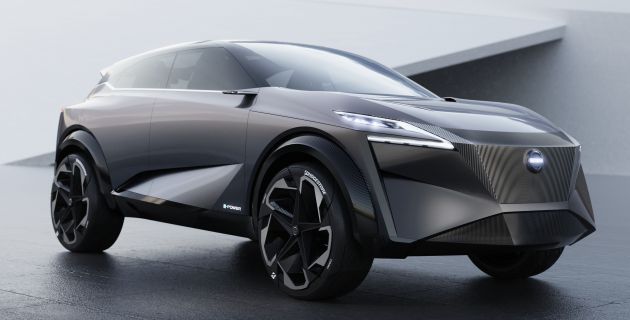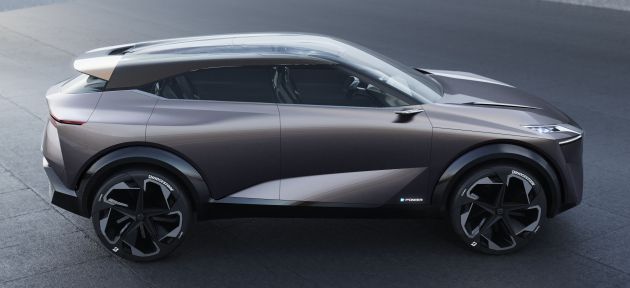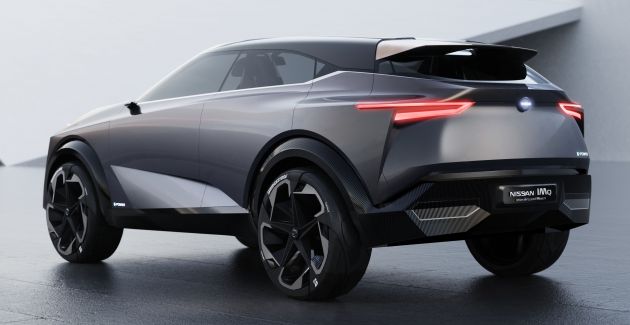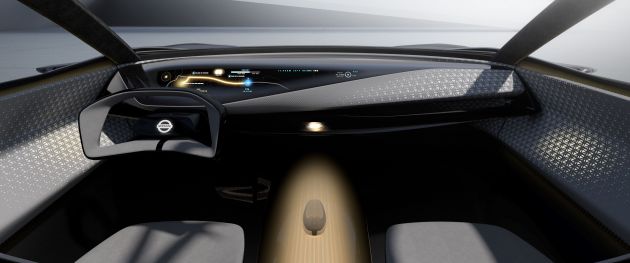This is the Nissan IMQ concept car that was recently revealed at the 2019 Geneva Motor Show. It’s described as an advanced technology and design showcase that signals the direction of the next generation of crossovers for Nissan.
The carmaker says that the IMQ seamlessly blends Japanese heritage with state-of-the-art, human-centric technology, and the styling reflects Nissan’s role as a pioneer and leader in crossovers, with a striking look that “pushes the boundaries of what a European crossover can be.”
Measuring 4,558 mm long and 1,940 mm wide, but just 1,560 mm tall (that’s 82 mm shorter and 120 mm wider than an X-Trail), the IMQ’s dimensions place it at the centre of the European C-crossover segment. Nissan says that this showcar marks a new direction in the brand’s design language.
It builds on the Nissan badge, integrated into the V-motion grille, which has been given a more subtle execution. The grille blends vertically into the hood and horizontally with the front bumper to create strong corners at the outer edges. The hood features chrome-edged cuts as the fender rises from the wheel arches and tucks under the central section.
At the back, a vertical character line drops from the light cluster to separate air as it passes down the side, aiding aerodynamic performance. At its upper end, it’s integrated into a new slimline interpretation of Nissan’s “boomerang” lamp signatures. The single-piece tailgate tucks under the rear fenders, echoing the design of the hood.
Closer inspection reveals extensive use of 3D ridges on the darkened lower sections of the exterior. These detailed layers – known as lamellas – are evocative of Japanese traditional design and extend all around the car. The exterior is completed by 22-inch wheels with Bridgestone Connect “smart tyres” that communicate info such as tyre load, pressure, temperature, grip level, wear and tyre health to the driver.
The Japanese design themes continue inside. The IMQ’s doors are hinged at their outer edges and open to reveal a futuristic space, featuring four individual seats that rise seamlessly from the lamella-covered floor, which provides a visual link to the exterior. Nissan’s “gliding wing” instrument panel dominates the dash, with a centre console emerging from beneath and stretching back between the front seats into the rear.
Each sculpted seat is finished in a two-tone 3D technical fabric, laser-cut in a geometric design inspired by Japanese kumiko woodwork. The pattern is replicated on the instrument panel, door trim and parcel shelf, as well as the metallic finish of the seat back. Lamellas have also been integrated into the door trim and seat back uppers as headrest supports.
The IMQ is powered by the next generation of e-Power, an electric motor drive system that has been further developed from the tech currently available in the JDM Nissan Note and Serena MPV. Here, it delivers 335 hp and 700 Nm of torque, channeled through a new multi-motor AWD system.
The IMQ offers additional insights into Nissan’s technology vision. It’s equipped with an advanced prototype version of Nissan’s ProPilot driving assistance system, which assists drivers on urban streets and suburban highways. It’s armed with an array of sensors, radars and cameras around the car that can interpret road, traffic and information signals.
Also on is Nissan’s Invisible-to-Visible (I2V) technology, unveiled at CES in January. I2V is a 3D interface where the real world converges with the virtual world. Developed by Nissan, it helps vehicle occupants see what may otherwise be invisible. The technology can help drivers see around corners, visualise precise info about traffic jams – including causes – and determine alternative routes. Drivers may even enjoy the company of a virtual passenger in the form of a 3D augmented-reality avatar.
The IMQ sounds like a serious proposal, and not just a flight of fancy. “The IMQ’s design combines traditional and modern Japanese influences and shows what’s possible when future crossovers are powered by Nissan Intelligent Mobility. The interior and exterior are seamlessly blended together, signalling what our design direction may be for Nissan’s third generation of crossovers in Europe,” said Alfonso Albaisa, senior VP for design at Nissan.
Source: Read Full Article




